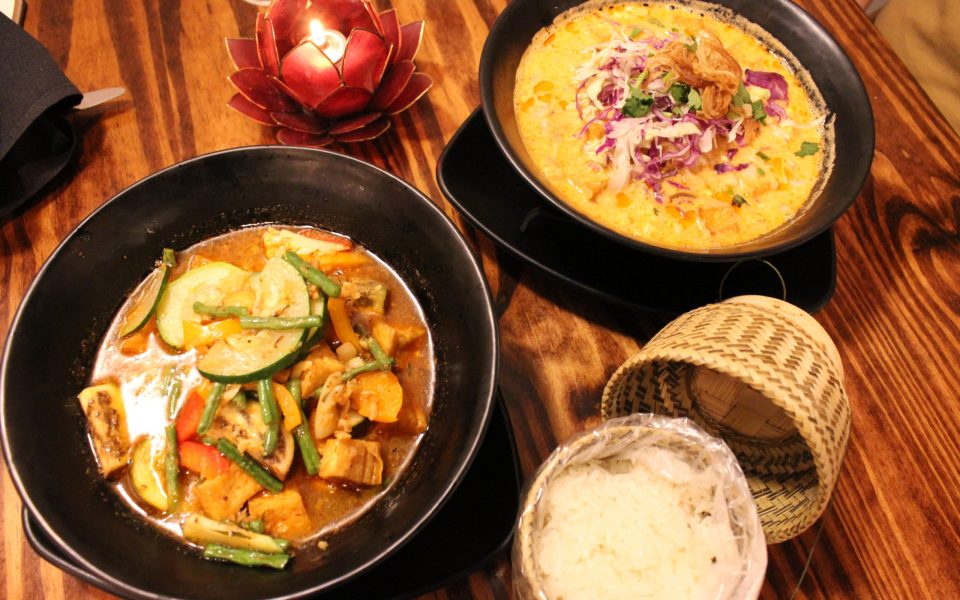Most people don’t know that Laos is the most heavily bombed country per capita in the world.
During the Vietnam War, the United States dropped more bombs on Laos — an effort to stop the infiltration of communist North Vietnamese forces — than on Japan and Germany combined in World War II. Because of the country’s long history of being caught in the middle of wars like this, many Laotians sought refuge in Thailand. Vonne Keobouala’s family was among them.
Short, with long, jet-black hair tied back in a low ponytail, Keobouala walks from table to table, greeting customers who have dropped in for an early dinner on a recent Thursday evening at Lao Restaurant + Bar in downtown Greensboro. The restaurant, which opened in late August in the former Crafted location on Elm Street, is Keobouala’s third restaurant but the first that focuses on Laotian cuisine.
Keobouala’s family fled Laos in the late 1970s; they came to the United States in February 1980, after a Catholic church in Illinois sponsored them. In 1985, in search of better jobs and weather, her family moved to California where her mother sold Laotian food out of a minivan. A few years after that, her brother moved to North Carolina for a job and then recruited the rest of his siblings. Keobouala was the last to move to Greensboro in 2005. Four years later, Keobouala and her brother, Jit “Matt” Lothakoun, carried on the restaurant tradition that their mother started with the popular restaurant, Simply Thai, in Elon. The restaurant debuted a second location in Jamestown late last year.
“When we settled in Greensboro, we knew there were lots of southeast Asians here,” Keobouala says. “But we decided to open Simply Thai because Thai food was more recognizable. Laotian food, no one knows.”
Because Laos is landlocked by Thailand, Vietnam, Myanmar China and Cambodia, influences from the other countries, especially Thailand, make their way into Laotian cuisine. But it’s still different and distinct, Keobouala says.
“It’s more herbal with more of a spicy kick,” she says. “It’s not as sweet as Thai food; it’s more funky.”
Despite North Carolina having the fifth largest Laotian population in the country, according to the 2017 census, there isn’t a whole lot of Laotian food in the area. There’s Lao Kitchen on Gate City Boulevard in Greensboro and Bida Manda in Raleigh.
Lao Restaurant + Bar is Keobouala’s way of changing that.
“We’re ready to share our story and our Laotian background,” Keobouala says. “We’re ready to bring authentic Laotian food to the table.”
Those who frequented the location when it was Crafted will remember the shotgun-style space, with a small entryway, then the narrow hallway that leads to a more open dining area. But gone are the lime-green walls and colorful accents. Instead, the surfaces have been painted white, with a black ceiling, dark wood elements and a few gold details to make up a minimalist color scheme.
The food, on the other hand, offers a more vibrant palette.
Flecks of bright-purple cabbage and fresh, green onion float in the mango-colored broth of a bowl of mee kati. A red coconut curry noodle soup, mee kati is just one of the noodle options on the restaurant’s menu. Thin, white rice noodles soak up the aromatic, sweet and spicy broth, creamy from a whipped egg that gets added towards the end of the process. The dish is warm and delicious, with crunchy pieces of peanuts that add nutty savoriness while vegetables like cabbage, bean sprouts and lemongrass bring a depth of texture.
The dish isn’t that common in Laos, according to Keobouala.
“We decided to offer it because we want to bring dishes like this so people can recognize them,” Keobouala says. “We want to introduce this food to the mainstream.”
Aom, on the other hand, is a traditional dish that’s popular throughout the country.
An earthy herbal stew made with fresh dill and green-striped Thai eggplant, aom offers subtle, peppery notes that make it a comforting dish in the cooler months of the year. Heavy with vegetables but light enough to eat a whole bowlful, aom is kind of like a Laotian minestrone.
“The dish is more common in central Laos,” Keobouala says. “It’s one of my favorite dishes because I like Thai eggplant and I like dill. Dill is what makes aom. I eat it with sticky rice.”
At an average of about $16 per entree, the dishes at Lao Restaurant + Bar aren’t too pricey but may be more than what customers are used to paying at similar Thai or Vietnamese restaurants. That’s because ingredients are hard to come by according to Keobouala. She says her family grows a lot of the herbs and vegetables used in the dishes like lemongrass and Thai chili to offset costs. She says the restaurant will soon introduce a lunch menu with prices averaging around $10.
But if you come for dinner, Keobouala says sharing is the best way to experience Laotian food. Start with the Lao sausage, made with pork, lemongrass, and dill; and a pile of Lao papaya salad, funky with shrimp paste; a side of sticky rice, Lao’s signature finger food, ready to be plucked, rolled and plunged in sauce; and an order of seen lod, or beef or pork jerky.
“When we first came, we were embarrassed or ashamed to bring out our food,” Keobouala says. “But now we want to carry on the tradition. Lao is special to us because I want to share our story and introduce the culture through food.”
Join the First Amendment Society, a membership that goes directly to funding TCB‘s newsroom.
We believe that reporting can save the world.
The TCB First Amendment Society recognizes the vital role of a free, unfettered press with a bundling of local experiences designed to build community, and unique engagements with our newsroom that will help you understand, and shape, local journalism’s critical role in uplifting the people in our cities.
All revenue goes directly into the newsroom as reporters’ salaries and freelance commissions.





Leave a Reply